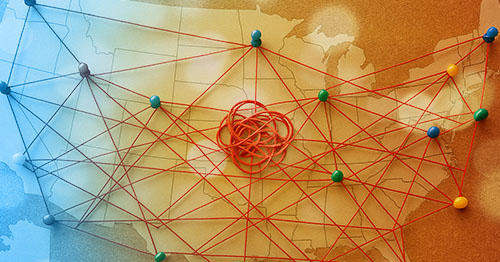
Untangling Complexity: How to Manage Multijurisdictional Matters in Modern Discovery
November 4, 2025
By:
Summary: Multidistrict litigation demands precision, speed, and coordination across a maze of data and discovery obligations. Here’s how proactive planning and strategic use of AI can help legal teams bring order, and efficiency, to even the most complex MDLs.
When litigation arising from a single product, incident, or investigation spans multiple jurisdictions and is consolidated into a multidistrict litigation (MDL), even seasoned legal teams can quickly feel the strain.
Counsel handling MDLs must navigate a storm of overlapping litigation priorities, varying regulatory demands, and mountains of data. It can feel like a herculean task to maintain a unified strategy that surfaces the information needed to prepare for each litigation, while meeting onerous discovery deadlines and obligations.
The key lies in getting ahead of the process through coordinated planning and a layered, scalable discovery process that works across the entire MDL. With strong upfront alignment and thoughtful use of technology, legal teams can manage even the most complex MDLs with speed, precision, and defensibility.
Below, I’ve outlined practical guidance for handling discovery in MDLs, drawn from recent rulings, emerging eDiscovery trends, and on-the-ground experience from the experts who regularly manage them.
1. Plan early across all jurisdictions
Early discovery planning is essential to align legal holds, ESI protocols, custodian lists, and search strategies across jurisdictions.
Laying that groundwork as early as possible is not just sound case management, it’s increasingly expected by courts. For example, a proposed amendment to the Federal Rules of Civil Procedure (FRCP) specific to MDLs is set to take effect in December 2025, and it reinforces this point. FRCP 16.1 encourages courts to require parties to file a report soon after the Judicial Panel on MDLs transfers cases, outlining their discovery plan along with the key factual and legal issues in dispute. The committee notes explain that this type of early planning helps streamline MDLs and conserve resources: “Experience has shown that in many cases an early exchange of information about the factual bases for claims and defenses can facilitate efficient management.”
Indeed, early planning can help surface weak claims sooner, enable defense teams to design more informed (and scalable) discovery plans, and build stronger, evidence-based litigation strategies, leading to better overall outcomes for clients.
“We’ve found that cross-jurisdictional success depends heavily on alignment in the first 30 days, especially around preservation and communication protocols. That early coordination pays dividends throughout the matter.”
— Raakib Bhuiyan, eDiscovery Analyst, Wilson Sonsini
2. Leverage AI to get ahead, but use the right tools for the job
AI has become an indispensable tool in MDLs because of the massive data volumes involved, often spread across multiple databases.
But different AI tools have different strengths and weaknesses. To get the most out of AI capabilities, it’s best to layer approaches and use the tools that are best fit for the job at hand.
Using AI to classify relevance and privilege
Predictive AI backed by large language models (LLMs) can be used within the traditional TAR workflows that attorneys are used to, providing a lower learning curve while still gaining the advantage of the newest AI. LLMs in predictive AI tools can more accurately classify relevance and privilege than older machine learning technology used in traditional TAR tools, while also providing more flexibility around ingesting new data and learning from it on the fly.
In MDLs, using predictive AI backed by LLMs for responsive and privilege review is especially helpful to:
- Reduce the burden of re-review by bucketing relevant documents to specific jurisdictions or RFPs
- Easily reuse privilege classifiers to maintain consistency across all cases removing risk for clients
“In complex MDLs, AI backed by LLMs can facilitate TAR workflows and reduce review for responsiveness significantly. We’re able to get documents to the right jurisdiction faster and with greater accuracy, so long as we build in the appropriate training and checkpoints.”
— Alison Shier, Vice President of Client Success, Lighthouse
Using AI to find key documents and prepare for deposition
LLMs grounded in an MDL’s data are uniquely suited to help case teams identify and summarize critical documents. Using AI for search in this way is both faster and more precise than traditional search, review, and fact-finding methods. In MDLs, the right AI search tools can be especially valuable for:
- Gaining a clear understanding of the key facts needed to shape strategy across different jurisdictions
- Uncovering important documents hidden within incoming third-party data
- Reducing or eliminating the need for issue coding during review, thereby accelerating workflows across jurisdictions
- Enhancing deposition preparation through faster, more targeted identification of the documents that matter most.
“With so many moving parts in an MDL, LLM-backed AI search tools can help litigation teams surface critical documents fast, get up to speed on the facts across jurisdictions, and prepare for depositions with confidence, without spending days crafting searches and reviewing redundant or irrelevant documents.”
— Vanessa Quaciari, Senior eDiscovery Counsel, Baker Botts
3. Address chat data sources (before the court does)
Today’s discovery landscape includes collaboration chat data such as Slack, Google, and Teams messages, as well as mobile data sources such as iMessage, WhatsApp, and Signal conversations.
Courts are increasingly holding parties accountable for preserving and producing chat data from corporate collaboration platforms. In Drips Holdings v. Teledrip, the court sanctioned a party for spoilation after it shortened its Slack archive retention period shortly before litigation. And in In re Google Play Store, the court awarded sanctions against a party based on the company’s policy of automatically deleting internal Google chat data within 24 hours.
Mobile messaging is another high-risk area. Courts issued numerous rulings in 2024 that reinforced the duty to preserve mobile data, even among individual custodians.
Therefore, early identification and preservation of these sources is critical. However, the challenge of identifying and preserving this data is amplified in MDLs due to the sheer number of custodians, sprawling volume of data sources, and dynamic preservation settings across different applications.
For example, if employees were given the discretion to preserve or delete chats on mobile phone applications, it can be difficult to ensure consistent and comprehensive preservation across dozens of relevant custodians. This can lead to gaps in collected data and allegations of intentional destruction of evidence.
“In MDLs especially, you can’t treat chat and mobile data like an afterthought or it will quickly lead to discovery issues (in an already complex discovery landscape). Data maps, custodian interviews, and ESI protocols need to account for these sources up front, especially when dealing with overlapping systems.”
— Kris Carpenter, Director, Modern Data Solutions, Lighthouse
4. Set up matters to reuse review decisions effectively
Due to overlapping discovery requests and priorities across jurisdictions, both case teams and document review teams often find themselves reviewing the same documents repeatedly. This wastes valuable time (and legal budget), while also leading to inconsistent review calls across matters.
Setting up your MDL from the beginning to plan for intelligent work product reuse, especially when paired with AI, can drastically help reduce redundant review, improve consistency, and keep review costs from ballooning out of control.
Examples of ways to reuse review decisions include:
- Privilege calls can be preserved and mapped to future productions in other jurisdictions or related investigations
- Reusable logic and AI classifiers can be used to ensure defensibility while dramatically speeding time to production
- Teams can set up a “universal” database, align on core responsiveness criteria across jurisdiction and use centralized review workflows to apply final coding, redactions, and issue tags that apply across all jurisdictions
“One of the challenges of an MDL is the necessity of having different teams re-reviewing the same documents multiple times. Not only does this raise time and budget concerns, it also could lead to inconsistent calls on the same document, which then requires additional QC review to rectify. But reaching agreements with opposing counsel to rely on already produced documents to avoid repeatedly reviewing the same documents may be one option for streamlining. Another option would be to create a coding approach that is not case specific from the outset of the matter. Of course, using AI tools appropriately can also lead to defensible productions across several related matters.”
— Irene S. Fiorentinos, Of Counsel, Jones Day
Final thoughts
The teams that excel in MDLs are those that plan early across jurisdictions, use AI strategically, and maintain clear communication throughout the process. By approaching discovery in MDLs with a proactive, integrated mindset, counsel can reduce inefficiency, manage risk, and stay aligned with evolving court expectations around data transparency.
Discover Lighthouse’s approach to multidistrict litigation and see it in action in this real-world case study.








